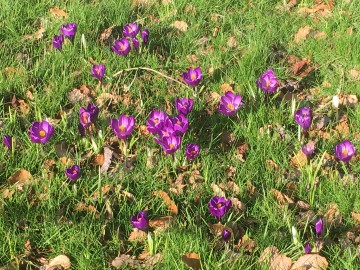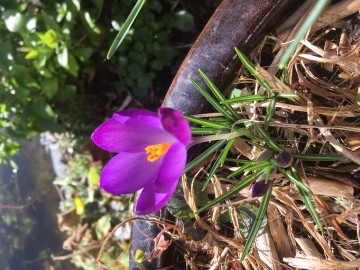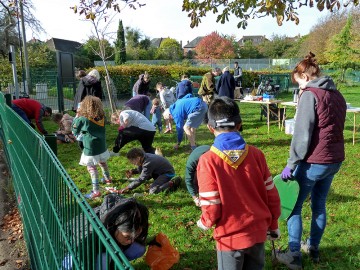![]() This page is regularly updated, please select here to view the latest version.
This page is regularly updated, please select here to view the latest version.
Crocuses Feb 2022

Photo taken at Hilliers Gardens - by Denise Long
If anyone’s visited Hillier’s Gardens recently, you will have seen the wonderful display of purple crocuses in the grass bank leading up to the entrance. Not only are they a beautiful reminder that spring’s on it’s way, but they’re also symbolic of the campaign by the International Rotary Club to eradicate Polio. The reason The Rotary Club chose this particular flower as the symbol is because each child that receives a polio vaccine is given a small purple mark on their finger to show they’ve been immunised. 25 years ago 350,000 children were infected, but thanks to the Rotary Club, and others, by 2015, there were only 74 cases. The countries where the disease still occurs, albeit in greatly reduced numbers, are Afghanistan, Pakistan and Nigeria. Hopefully, not for much longer!

Photo taken at Hilliers Gardens - by Denise Long
We are fortunate at the Rec, having been donated 1000 purple crocus corms by the Southampton branch of the Rotary Club in recognition of their fund raising efforts towards the campaign. These bulbs were planted last November, in the corner just behind the noticeboard at the Grosvenor Rd entrance. And we were ably assisted in carrying out the task by local Scout Group and others.
Crocuses are not native to the UK but have been a firm favourite here for many years. They naturally occur in countries around the Mediterranean across to the Middle East and into Central Asia. And they also inhabit a wide variety of habitats from sea level to alpine tundra. In the UK we have both spring and autumn flowering crocuses, but it’s the former that are so important for early pollinators, especially bees.
Crocuses usually flower from February through to March. They grow from underground corms and because their flowers and foliage have a waxy coating, they’re able to survive a certain amount of frost and snow. The 6 petals of the crocus are either purple, yellow or white and they close at night or in dull conditions. The leaves are narrow and lance shaped with a central pale stripe.
Crocuses rely on insects for their fertilisation as their pollen is too heavy and sticky to be carried by the wind. Early flying Queen Bumblebees, amongst others, provide this service but also benefit in the process. They require sugary nectar to provide them with energy and protein rich pollen for their larvae. In the course of harvesting these substances from the flowers, they also transfer some of the pollen from the male part (anther) where it’s produced, to the female part (stigma) thereby cross fertilising the plants. The pollen sticks to the hairs on their bodies or in some cases, the female has specially adapted hairs on her back legs in which to gather the pollen; commonly known as pollen sacs. In crocuses the long tubular flower means that the nectar is only readily accessible to long tongued bees such as the Garden Bumblebee, but other species still visit, attracted by the colour, scent and easy to reach pollen. In the absence of this super appendage, some sneaky insects will bore holes at the base of certain flowers to be able to get at the nectary.
Photo by Denise Long
 The pollen deposited on the stigma stimulates the growth of a pollen tube, down which it travels to reach the ovary, which in the crocus, is below the ground. Seeds then develop in a 3 lobed seed pod which can be seen at the base of the plants as they die back. The pods ripen and split open to cast out a number of seeds. Crocuses can also propagate asexually by producing small ‘daughter’ corms that develop from the body of the ‘parent.
The pollen deposited on the stigma stimulates the growth of a pollen tube, down which it travels to reach the ovary, which in the crocus, is below the ground. Seeds then develop in a 3 lobed seed pod which can be seen at the base of the plants as they die back. The pods ripen and split open to cast out a number of seeds. Crocuses can also propagate asexually by producing small ‘daughter’ corms that develop from the body of the ‘parent.
By both these means, and given the right conditions, crocuses are able to spread quickly.
We knew we had to plant our donated corms in the right position, which can be a little challenging at the Rec, given the tendency for the ground to become fairly saturated. Most bulbs and corms like free draining conditions, otherwise they are liable to rot. Crocuses also prefer to be in the sunshine which encourages their petals to open and welcomes in the pollinators. I also think they look at their best when
Photo by Denise Long naturalised in grass. So, with the advice of the Council we opted for the corner near the entrance. Thankfully the squirrels don’t appear to have dug them up, as I believe they’re rather partial to crocus bulbs. I also agonised about
whether we were planting them at the right depth, having read a number of articles stressing how important this was to their success, or otherwise. Little did I know that these miniature little super stars have what’s called, contractile roots. These anchor the corms into the soil and react to things such as temperature and light levels to adjust the position of the plants for optimal growth. Nature never ceases to amaze!!
So although our crocuses are understated beauties at the moment, we hope that year on year the display will increase. We can then be proud of the fact that we’ve highlighted a really worthy cause, provided lots of sustenance for early pollinators and hopefully brought a smile to the faces of park visitors.
With special thanks to the Southampton Branch of the Rotary Club and the 29th Immaculata Scout Group

Photo by Bruce Larner
![]()


